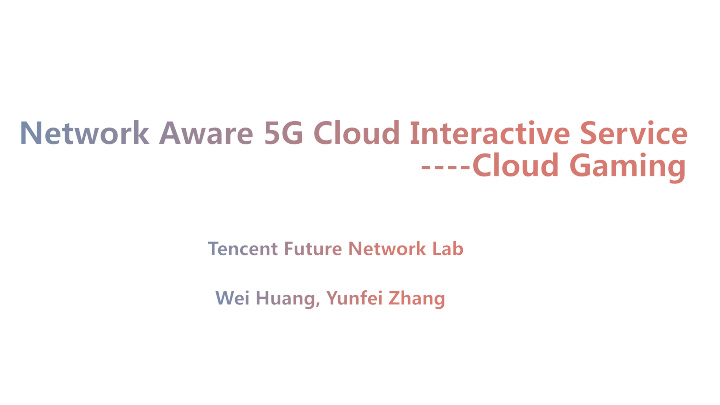



• Tencent Cloud Gaming • Tencent Instant Play and Tencent START • Already started the Collaboration with three Chinese Operators to provide cloud gaming services • SonyPlayStationNow • https://www.trustedreviews.com/opinion/what-is-playstation-now-a-guide-to-sony-s-streaming-service- 2920562 • Microsoft xCloud • https://blogs.microsoft.com/blog/2018/10/08/project-xcloud-gaming-with-you-at-the-center/ • Liquidsky iCDN • https://enterprise.liquidsky.com/technology.html • Google Cloud • nVIDIA GeForce NOW • PaperSpace
• Quick start & less local installation • No need to download gaming software for installation thus saving the time to start, time spend include both the download and installation time • Less CPU power required for rendering • No need to perform rendering with high-end processors • More device availability • Game can be played in most devices even without high end processors • Seamless switch • Less Piracy • Games are played on or rely on cloud servers
Cloud Gaming vs. Traditional Gaming • Volume • 30Mbps vs. 300kbps • User Client • Any equipment with decoder vs. Need expensive GPU • Technical • I,P frame vs. Operation instruction Cloud Gaming vs. Live streaming and video conference Client Side • No buffer or very small buffer vs. 2-8 seconds buffer • Delay Tolerance • Sensitive <100ms mostly vs. Several seconds • Interactive service is regarded as a potential killer application in 5G
Present Resource Allocation in Cloud Gaming are based on IP, which can only • show the city level. Problem Mana Cloud Gaming Frame If too many MEC in one city,service may occur 404 or 302 • geme nt TMEC ability Central DC Flow dyeing • Support DP of many companies • Cloud Gaming Server TMEC Flow dyeing Edge DC User Plane Function(UPF) Edge UPF NOKIA DP ZTE DP Intel DP … Base Station Cloud Gaming Video Request/Respond 6
Server Server Network Network Gaming Program Gaming Program User User Gaming Logic Gaming Logic Rendering Rendering Client Client Streaming Streaming Packeti Packeti Decode Decode ng ng Source Image Source Image Operation Operation Interpretation Interpretation Operational Operational Saliency Saliency instruction instruction Encode Encode detection detection Adaptive Adaptive and User and User Network Network bitrate bitrate Status Status Rate Value Rate Value Status Status streaming streaming User User Operational Operational Status Status instruction instruction 7
Problem: Delay and Jitter Huge Video Size vs. Limited Bandwidth High Quality and High Delay Low Quality and Low delay Saliency Detection: 1 Find the region of Interest 2 Saving bandwidth without harming users ' experience 3 Reducing peak bitrate Our Work: 1 Increase the detection accuracy à Saving about 30% bandwidth under same QoE 2 Reduce detection speed à only 10ms-30ms 3 Changing algorithms and rate allocation (in one frame) based on the network status Balance between detection delay and detection accuracy 8
High rate may cause delay Low rate may harm the quality of experience Most users are in wireless network (60% ↑ keep increasing) Network fluctuation To avoid large delay and guarantee quality: Video rates need to change with the network Traditional Methods : Reaction lag • Not applicable to Difficult on Trade off between Rate and Delay • cloud gaming Rely on Client Buffer • 9
Our Work: AI-based method (RL) to improve accuracy in cloud gaming environment • ABR on Delay Sensitive Scenario (Without Buffer) • Collecting Network Information (both from user client and server) to predict the best video rate • Reward Agent State Traditional AI-based Bandwidth 25M+ (PC) 15M-20M (PC) Past rate 10M (Mobile) <8M (Mobile) Current delay>200ms Once every 2 Once every 4 Action buffer minute minute Environment Frame delay RTT time Score 1700+ 2800+ (much Rate Value Lost rate (Dealy+rate+ higher) switch …… frequency) 10
Data Source: Client side; Server side; Network side Goal: Predict the change of network; balance between delay and rate Future: Need more kinds of information which can reflect the network status (from operator and MEC) Network Capability Exposure : More information type reflect network status to help Reinforcement Learning à predict network performance • More frequency and more precise to help increase accuracy à to millisecond level and user level • Client Information (frame delay, Server Information (RTT time , buffer status) video rate, frame rate, frame size…) Uplink Channel Direct Connect Application Private Link Network Information (loss rate, cell load, mobile position information…) 11
1 Enhancing the experience of cloud gaming, reduce latency 2 Provide classified protection to users according to the different needs Transport Core User Client Network Network slicing network channel1 3 slicing VIP modes user1 Server 1 Slicing user2 Mobile number • (application 5G BS1 VIP slicing data application • /mobile UPF1 position • number) Common data UPF2 Common user3~N 5G BS2 … Common channel Server 2 13
Recommend
More recommend